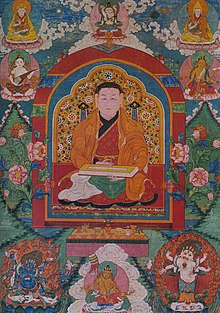
Back জানাবাজার Bengali/Bangla ཁལ་ཁ་རྗེ་བཙུན་དམ་པ་བློ་བཟང་བསྟན་པའི་རྒྱལ་མཚན་ Tibetan Dzanabadzar Czech Dsanabadsar German Öndör Gegeen Zanabazar Spanish Dzanabadzar Estonian Zanabazar French Dzanabadzar Gombodordzsin Hungarian Zanabazar ID Zanabazar Italian
Öndör Gegeen Zanabazar Jebtsundamba Khutuktu | |
|---|---|
 Self-portrait, late 17th or early 18th century | |
| Personal | |
| Born | Eshidorji 1635 |
| Died | 1723 Beijing, Qing dynasty, China |
| Resting place | Unknown |
| Religion | Buddhism |
| Nationality | Mongolian |
| Denomination | Tibetan Buddhism |
| Lineage | Gelugpa (Yellow Hat) |
| Senior posting | |
| Reincarnation | Taranatha |
Öndör Gegeen Zanabazar[a] (born Eshidorji)[b] was the first Jebtsundamba Khutuktu[c] and the first Bogd Gegeen or supreme spiritual authority, of the Gelugpa (Yellow Hat) lineage of Tibetan Buddhism in Mongolia.[2]
The son of a Mongol Tüsheet Khan, Zanabazar was declared spiritual leader of Khalkha Mongols by a convocation of nobles in 1639 when he was just four years old. The 5th Dalai Lama (1617–1682) later recognized him as the reincarnation of the Buddhist scholar Taranatha and bestowed on him the Sanskrit name Jñānavajra (Sanskrit: ज्ञानवज्र, Zanabazar in Mongolian) meaning "thunderbolt scepter of wisdom".[3] Over the course of nearly 60 years, Zanabazar advanced the Gelugpa school of Buddhism among the Mongols, supplanting or synthesizing Sakya or "Red Hat" Buddhist traditions that had prevailed in the area, while strongly influencing social and political developments in 17th century Mongolia.[4] His close ties with both Khalka Mongol leaders and the devout Kangxi Emperor facilitated the Khalkha's submission to Qing rule in 1691.
In addition to his spiritual and political roles, Zanabazar was a polymath – a prodigious sculptor, painter, architect, poet, costume designer, scholar and linguist, who is credited with launching Mongolia's seventeenth century cultural renaissance. He is best known for his intricate and elegant Buddhist sculptures created in the Nepali-derived style, two of the most famous being the White Tara and Varajradhara, sculpted in the 1680s. To aid translation of sacred Tibetan texts, he created the Soyombo script from which sprang the Soyombo that later became a national symbol of Mongolia. Zanabazar used his artistic output to promote Buddhism among all levels of Khalkha society and unify Khalkha Mongol tribes during a time of social and political turmoil.[5]
- ^ "Zanabazar, Aristocrat, Patriarch and Artist (1635-1723)", pp. 70–80 in The Dancing Demons of Mongolia, Jan Fontein; John Vrieze, ed.; V+K Publishing: Immerc. [1999]
- ^ various (2007). World and Its Peoples: Eastern and Southern Asia, Volume 2. Marshall Cavendish. p. 262. ISBN 978-0761476313. Retrieved 23 May 2016.
- ^ Martha, Avery (2003). The Tea Road: China and Russia Meet Across the Steppe. 五洲传播出版社. pp. 107–108. ISBN 7508503805.
- ^ Huntington, John C.; Bangdel, Dina; Thurman, Robert A. F. (2003). The Circle of Bliss: Buddhist Meditational Art (Illustrated ed.). Serindia Publications, Inc. p. 236. ISBN 1932476016.
- ^ Wallace, Vesna A. (2015). Buddhism in Mongolian History, Culture, and Society (illustrated ed.). Oxford University Press. p. xix. ISBN 978-0199958665.
Cite error: There are <ref group=lower-alpha> tags or {{efn}} templates on this page, but the references will not show without a {{reflist|group=lower-alpha}} template or {{notelist}} template (see the help page).
© MMXXIII Rich X Search. We shall prevail. All rights reserved. Rich X Search